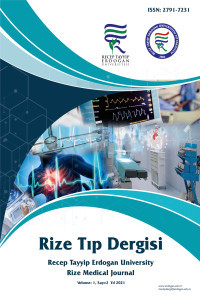Epidermolizis Bülloza ve Pylor Atrezisi
Epidermolysis bullosa, genellikle otozomal dominant veya resesif genetik geçişli bir sendrom olmakla birlikte; daha az oranda sporadik vakalar halinde de görülebilir. Özellikle aile anamnezi bilinmeyen vakalarda; gestasyonel dönemde epidermolysis bullosa tanısı koymak oldukça güçtür. Gestasyonel dönemde ultrasonografide; gastrik dilatasyon, polyhidroamnios ve amniotik sıvıda ekojenite görülmesi halinde epidermolysis bullosa sendromunun varlığını düşünmek gecikmiş tanıları önleyebilir . Epidermolysis bullosa sendromu şüphesinde; fetüste karyotipleme yapılması, maternal serumda alpafetoprotein seviyesinin ölçülmesi ve amniotik sıvıda asetilkolinesteraz bakılması tanıda yardımcı olabilir. Bizim vakamızda, gestasyonel 32. Gebelik haftasında gastrik dilatasyon ve polihidroamnios varlığı saptadık ve aile anamnezi olmayan olgumuzda epidermolysis büllosa sendromu varlığından şüphelendik. Bu vaka sunumumuzda; 32. gestasyonel haftada yapılan ultrasonografi ile gastrik dilatasyon ve polihidroamnios saptanıp ve epidermolizis büllosa tanısından şüphelenilen hastanın neonatal dönemdeki tanısını ve hastalığın prognozunu bildirmeyi hedefledik.
Anahtar Kelimeler:
Epidermolizis Bülloza, Büllöz Deri Hastalıkları, Vezikülobüllöz Deri Hastalıkları
___
- 1- Lanschuetzer CM. Classification and molecular basis of hereditary epidermolizis bullosa. In: Fine JD, Hintner H, editors. Life with Epidermolizis Bullosa (EB). Austria: Springer Wien-New York; 2009.
- 2- Fine JD, Eady RA et all. The classification of inherited epidermolizis bullosa (EB): Report of the Third International Consensus Meeting on Diagnosis and Classification of EB. J Am Acad Dermatol. 2008;58:931-50.
- 3- Fine JD, Johnson LB et all. Gastrointestinal complications of inherited epidermolizis bullosa: cumulative experience of the National Epidermolizis Bollosa Registry. J Pediatr Gastroenterol Nutr 2008;46(2):147-58.
- 4- Fine JD, Eady RA et all. The classification of inherited epidermolizis bullosa (EB): Report of the Third International Consensus Meeting on Diagnosis and Classification of EB. J Am Acad Dermatol 2008;58(6):931-50.
- 5- Yiasemides E, Walton J et all. A comparative study between transmission electron microscopy and immunofluorescence mapping in the diagnosis of epidermolizis bullosa. Am J Dermatopathol. 2006;28:387-94.
- 6- Ardaens Y. Pathologie de la paroi et du contenu abdominal. In Echographie en pratique obst´etricale, Robert Y, Gu´erin du Masgenˆet B, Ardaens Y (eds). Masson: Paris, 2000; 269–284.
- 7- Okoye BO, Parikh DH et all. Pyloric atresia: five new cases, a new association, and a review of the literatüre withguidelines. J Pediatr Surg 2000; 35: 1242–1245.
- 8- Petrikovsky B, Schneider EP et all. Clinical significance of echogenic amniotic fluid. J Clin Ultrasound 1998;26: 191–193.
- 9- Konefał H, Gawrych E et all.(Congenital epidermolizis bullosa--a case report). Ginekol Pol. 2012 Oct;83(10):792-4.
- 10- Nakano A, Pulkkinen L et all. Epidermolizis bullosa with congenital pyloric atresia: novel mutations in the beta-4 integrin gene (ITGB4) and genotype/phenotype correlations. Pediatr Res 2001; 49: 618–626.
- 11- Koss-Harnes D, Høyheim B et all. A site-specific plectin mutation causes dominant epidermolizis bullosa simplex ogna: two identical de novo mutations. J Invest Dermatol. 2002;118:87-93.
- 12- Pfendner Ellen G, Lucky Anne W. Epidermolizis bullosa with pyloric atresia. In: Gene Reviews. Initial Posting: August 21, 2006. Last Update: October 4, 2007.
- 13- Pfendner EG, Lucky AW. Dystrophic Epidermolizis Bullosa. In: GeneReviews. Initial Posting: August 21,2006.: October 4, 2007.
- Başlangıç: 2020
- Yayıncı: Recep Tayyip Erdoğan Üniversitesi
Sayıdaki Diğer Makaleler
22 yaşında erişkin yaşta teşhis edilen bronşektazili pulmoner hipoplaz
Ayhan KANAT, Bülent ÖZDEMİR, Vacide AŞIK ÖZDEMİR, Elena ROMANA GASENZER
Epidermolizis Bülloza ve Pylor Atrezisi
Şenol ŞENTÜRK, Gülşah BALIK, Figen KIR ŞAHİN, Mehmet KAĞITÇI
HİPOPOTASEMİ İLE GELEN PANKREAS KANSERİNE BAĞLI EKTOPİK ACTH SENDROMU: VAKA SUNUMU
Hatice BEYAZAL POLAT, Teslime AYAZ, Damla TÜFEKÇİ, Osman CÜRE, Kadir İLKKILIÇ, Uğur AVCI, Bayram KIZILKAYA
An Uncommon Cause of MINOCA: Mad Honey Poisoning
Handan DUMAN, Gökhan BARUTÇU, Elif ERGÜL
Bir çift monozigotik ikizde kopya efektli miyopik anizometropi: Bir Olgu Sunumu
